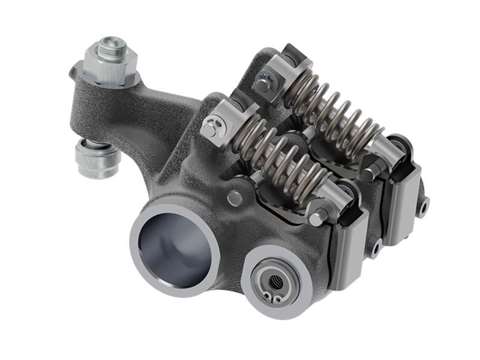Eaton’s CDA, LIVC get high marks from FEV
28 February 2023
Eaton’s Vehicle Group has reported that independent testing has established that the company’s cylinder deactivation (CDA) and late intake valve closing (LIVC) technologies have been proven to simultaneously reduce nitrogen oxides (NOx) and carbon dioxide (CO2) in diesel engines.
A series of tests undertaken by global engineering consultant FEV indicated that the technologies were are effective for meeting future global emissions requirements for diesel-powered commercial vehicles.
 Recent testing has shown that Eaton’s cylinder deactivation (CDA) and late intake valve closing (LIVC) technologies can simultaneously reduce nitrogen oxides (NOx) and carbon dioxide (CO2) in diesel engines. (Photo: Eaton)
Recent testing has shown that Eaton’s cylinder deactivation (CDA) and late intake valve closing (LIVC) technologies can simultaneously reduce nitrogen oxides (NOx) and carbon dioxide (CO2) in diesel engines. (Photo: Eaton)
During the evaluation, the standard valvetrain on an 11 L diesel engine was replaced with Eaton’s variable valve actuation system able to deliver either CDA or LIVC functions. The engine was put on a dynamometer and tested in standard engine and in varying CDA and LIVC engine modes to determine optimal thermal management effects and fuel savings.
The testing measured fuel consumption and exhaust temperature, from which engine-out NOx and CO2 emissions were determined. Eaton said that results indicated the CDA created up to a 38% reduction of NOx compared with 13% for LIVC. This was attributed to increased exhaust gas temperatures, which enable optimal emissions aftertreatment performance. The results were delivered while simultaneously reducing CO2 emissions, Eaton said.
The CDA system also resulted in a 3% decrease in fuel consumption in a low-load cycle, while LIVC lowered fuel consumption by 0.5%. Additionally, CDA in three-cylinder mode raised exhaust temperatures up to 347º F (175º C), which helped increase the efficiency of a selective catalytic reduction (SCR) system.
“Emissions regulations are driving the adoption of variable valve actuation solutions by our global commercial vehicle customers,” said Fabiano Contarin, product director, Commercial Vehicle Valve Actuation, Eaton’s Vehicle Group. “Our portfolio of technologies is helping manufacturers meet the upcoming regulations in a number of ways based on customer preference.”
The study results confirm earlier findings of tests conducted in the U.S. by Eaton and the Southwest Research Institute (SwRI). The findings of the U.S.-based tests found using CDA and a close-coupled selective catalytic reduction (SCR) catalyst reduced CO2 emissions by 4% in a low load cycle with NOx emission of 0.02 g/hp-hr.
“If a low-load cycle is a customer’s focus, then CDA is the ideal technology,” Contarin said. “LIVC, instead, provides lower benefits but in a wider range of the engine map, especially when combined with a higher compression ratio.”
STAY CONNECTED




Receive the information you need when you need it through our world-leading magazines, newsletters and daily briefings.
POWER SOURCING GUIDE
The trusted reference and buyer’s guide for 83 years
The original “desktop search engine,” guiding nearly 10,000 users in more than 90 countries it is the primary reference for specifications and details on all the components that go into engine systems.
Visit Now
CONNECT WITH THE TEAM









